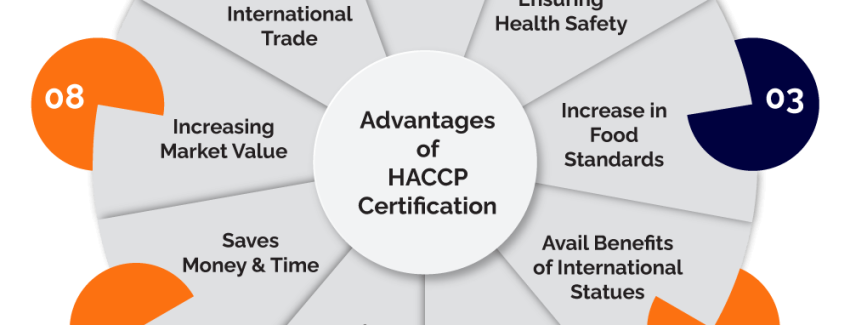What is HACCP?
HACCP Standard: HACCP (Hazard Analysis and Critical Control Points) is a food safety management system designed to identify, evaluate, and control hazards during the production, processing, and storage of food. This standard is widely adopted worldwide and has become an essential requirement in the food industry, helping businesses ensure that their products meet the highest safety standards.
HACCP focuses on identifying Critical Control Points (CCPs) to prevent potential risks.
Why is HACCP important?
Implementing a HACCP plan reduces the risks to consumers by controlling potential hazards that may be found in food. It also reduces the recall of any products that may have been contaminated due to processing or human error. HACCP means that food safety hazards are a priority for food businesses. This helps to prevent foodborne illnesses and allergic reactions.
What is HACCP used for?
The HACCP system is suitable for all organizations involved in the food supply chain, including manufacturers, processors, packers, distributors, restaurants, and food service providers. Any organization that deals with the production and supply of food can benefit from implementing HACCP to ensure the safety of its products
Essentially, HACCP is a preventative measure and helps businesses not only avoid hazards but also the associated costs that hazards bring such as stock destruction or product recalls. Having a HACCP plan also provides evidence of due diligence if there were to be any legal action resulting from food contamination. All food businesses must have a HACCP plan as a legal requirement
What are the main principles of HACCP?
Every food business must have a HACCP plan based on seven principles. This plan must ensure that food is kept safe from hazards including biological, chemical, physical, and allergenic hazards.
1. Conduct a hazard analysis: The first part of an HACCP plan looks at evaluating a food business’s processes and identifying where hazards could be introduced. Hazards can be biological, chemical, physical, or allergenic.
A biological hazard is something such as bacterial or viral contamination that would cause a foodborne illness, for example, E. coli, salmonella, or Campylobacter.
A chemical hazard is a hazard where a chemical could contaminate food such as a cleaning product used on a surface.
A physical hazard could be where parts of machinery or tools could contaminate food such as metal or plastic fragments.
An allergenic hazard concerns contamination through the unwanted presence of allergens. The Food Standards Agency (FSA) follows the EU which states 14 main food allergens that must be labeled on the packaging. These are celery, cereals containing gluten, crustaceans, eggs, fish, lupin, milk, mollusks, mustard, tree nuts, peanuts, sesame seeds, soybeans, and sulfur dioxide/sulfites (at certain concentrations).
The person carrying out the hazard analysis must be equipped with the knowledge and experience to do so. If not, the business must employ an external person to perform the analysis. Once hazards have been identified, the next step is evaluating the hazard and its potential risks. This helps to determine the severity of risk from a hazard.
2. Identify Critical Control Points (CCPs) Once all hazards have been identified and analyzed, the next step is to identify CCPs. CCPs are points where a hazard needs to be controlled as it presents a risk. At each CCP, preventative measures should be in place to prevent the hazard from occurring. This may mean that temperatures, time, pH, or certain procedures are monitored either by machine or by individuals.
3. Establish critical limits Once the control points have been established, the next step is establishing critical limits to control the hazard. For some elements, there may be regulatory limits such as temperatures of storing food. Each CCP must have a limit attached to it e.g. a specific time, pH level, chlorine level, salt level, or temperature. If the critical limit is exceeded, corrective action is essential to maintain control over the product.
4. Establish a monitoring system
When critical control points and limits have been established, it’s not enough just to have them in place. An effective monitoring system is needed otherwise nobody would know whether the critical limits have been exceeded. A business must implement an effective system for monitoring limits to show that all procedures are controlled effectively. If this step does not happen, the HACCP is effectively worthless.
Physical observations on a regular, established basis will help ensure that the HACPP is effective. Good monitoring means that action can be taken to control a situation and rectify it before the hazard becomes out of control.
5. Establish corrective actions
If a critical limit is exceeded or not met, the HACCP plan must outline what needs to happen next to correct it. Any corrective action needs to ensure that any product or foodstuff is removed and does not pass on to the next stage of processing.
At this point, corrective actions should also include analyzing how the problem occurred and fixing the cause of the problem. Corrective actions must control what is produced and released as well as prevent the situation from happening again
6. Establish record-keeping procedures Food businesses must keep accurate records to prove that all their critical limits have been monitored and met and that their production system is well controlled. There are regulatory requirements in certain areas for this.
7. Establish verification procedures Every business’s HACPP plan must be checked and validated. This ensures that the plan is effective at preventing hazards. The end product should also be tested to check that all controls are effective. It’s also important that record-keeping measures are checked and monitored too.
If all the above principles are followed by food businesses, this minimizes risks to consumers when it comes to the foods they eat.
Benefits for Businesses Implementing HACCP

Implementing HACCP provides numerous benefits for businesses, including:
• Ensuring food safety: Minimizing the risk of foodborne illness and protecting consumer health.
• Enhancing reputation and customer trust: Achieving HACCP certification enhances brand image and builds trust with customers.
• Compliance with legal regulations: HACCP is a mandatory requirement in many markets and industries, and its implementation helps businesses comply with food safety regulations.
• Improving operational efficiency: The HACCP system helps organize production processes, thereby optimizing resources and reducing waste.
Why Choose FAST CONSULTING for HACCP
We pride ourselves on being a leading consulting firm in establishing HACCP systems.
Our team of experts has many years of experience and extensive knowledge in the field of food safety, ready to accompany you throughout the implementation and certification process of HACCP. We are committed to providing high-quality consulting services that help businesses not only meet standard requirements but also optimize production processes, thereby enhancing the effectiveness and safety of their products.
With FAST, you can be assured of the quality and reliability of our HACCP consulting services
Let FAST CONSULTING accompany you on the journey to build a strong food safety management system, protect consumer health, and enhance your brand value. Contact us today for a detailed consultation!
